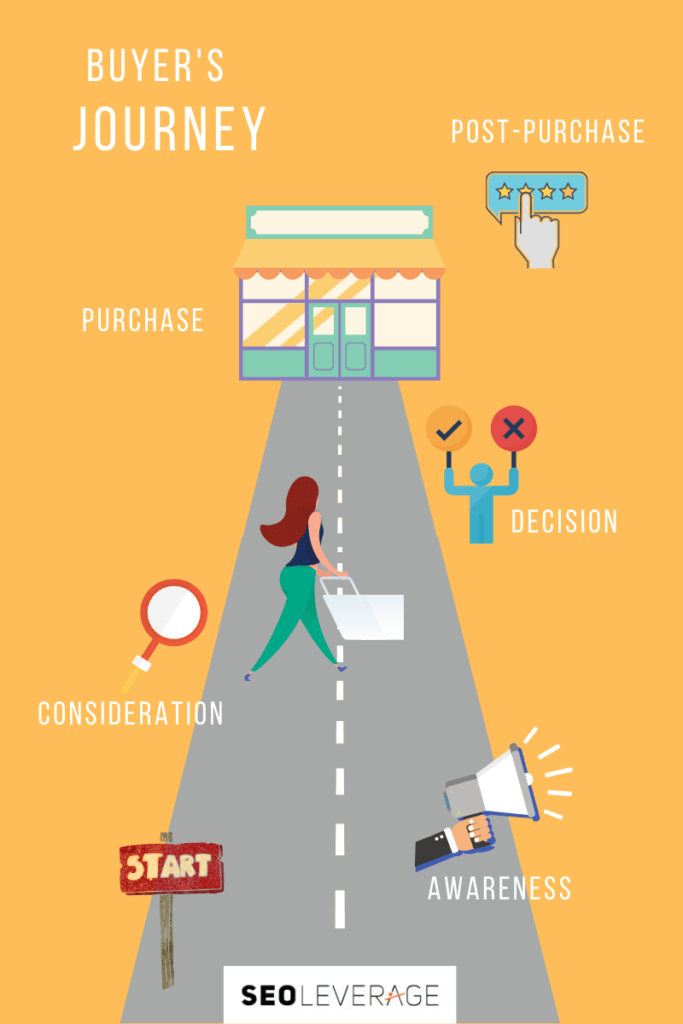A content map allows you to deliver content to the right individual at the best time. It's all about targeting your prospective audience while working on your content's gaps and opportunities.
After all, you wouldn't want to waste your time and money over a marketing strategy just to be shunned by your buyers because it's not for them.
But creating a content map can be a bit tricky if you haven't done it before. For it to be effective, you need to follow these five steps.
The first step to creating a content map is collecting two pertinent pieces of information: the buyer persona and the buying journey.
The buyer persona is the generalization a content marketer makes based on the client's purchasing behavior. It can be grounded on a lot of things, so the best way to get these important factoids is to do market research.
It's as basic as creating surveys and interviewing your buyers regarding their desires and pain points. Whatever method you choose, you need to take note of the following points:
Simply put, a buyer persona can help you create content based on an individual's behavior, needs, and perceived challenges. While it's good to work on multiple personas, start with one or two if you are new to this.

This refers to the client's progression from item awareness to consideration (research) to the decision (purchase) itself – and even beyond that.
With this, you can generate efficient content for every step of the process. After all, this allows you to make more connections so you could close more purchases in the long run.
During this stage, the buyer persona is looking for resources that can help him/her determine a problem or possible opportunity. It's all about looking up info about the issue, its causes, and what can be done about it.
Now that your buyer knows that he/she needs something, he/she will go about looking for solutions to the pressing issue.
If you want to appeal to clients at this stage, it's all about telling them that your product or service is the best out there.
As the name suggests, this is the time when the buyer has gauged all the options. He/she is all set to make a purchase.
With many options out there, it's time for you to affirm your product's worthiness.
This is the act of buying itself – a testament that you've done your research and interventions well.
Although this is the case, the purchase does not mark the end of the content curation road. You need to develop a good relationship for loyalty's sake.
This final phase of the journey is all about the client determining whether he/she is happy or disappointed with the purchase. It's all about creating value so that your customers will come back once again.
Remember, it's more cost-effective to have a returning client than to work your way on getting a new one.
Before you start with content marketing, you need to know which content is applicable for each phase. This will help you create content that appeals to the buyer, no matter what stage he/she is in.
Determining the applicability of the content could help you optimize your efforts.
For example, your website may be generating traffic, but these visitors leave without buying anything. This may mean that your top-of-the-funnel material is not working.
The same applies when you need more leads. Even if you are continually converting, the lack of new leads may mean that you need to work on material that targets buyers in the awareness phase. This will also prevent you from seeming too pushy.
When you understand what the buyers need at each stage, you can match your marketing approach to suit them. This, in turn, could lead to better conversion rates. Your clients will come to you without you forcing them.
The content marketing strategy for this stage is all about helping the individual with the discovery process. It's all about attracting new clients by supplying answers to their questions or needs.
For this stage, you can lure buyers with comprehensive social media posts, interactive content, checklists, blogs, infographics, and videos.
This is all about keeping your prospective buyers. For this, you are going to need email newsletters, expert guides, product brochures, comparison charts, demo videos, and case studies.
Here, you need to convince your buyers that they are making the right choice.
You can do this by crafting middle-of-the-funnel content, such as datasheets, product lists, webinars, landing pages, marketing case studies, testimonials, webinars, e-books, and whitepapers.
This is the time for you to close the deal. You wouldn't want your client to have a sudden change of mind, after all.
You can do this with bottom-of-the-funnel content examples, which include FAQs, free consultations, reviews, live demos, and free trials.
Apart from providing support, you need to re-engage your buyers so that they'll come back again.
This is an opportune time to present coupons, surveys, user guides, email newsletters, and customer portals.

To save yourself from the labor of making redundant content, you need to make an inventory of the related content at hand. When you do so, be sure to take note of the following details:
Now that you're done aligning content themes, it's time to map them accordingly. It would be best if you considered the following things as you do this:
As mentioned, different content types are needed for each phase of the buyer's journey.
Take a look at your existing content to see where it fits. Is it during awareness, consideration, evaluation, purchase, or post-purchase?
What is your content telling the client? See to it that the call to action helps the customer transition into the next phase of the buying journey.
The content creation road can only be made better with efficient content. Even if you have lots of blog posts and videos, they're all for naught if they are of low quality.
While they don't fit your content map right now, you could revise and repurpose them for your next service blueprint.
By this time, you should have made a content map that aligns your existing content with your buyers' journeys. As such, the next best thing to do is to mind the gaps that you have on your map.
The focus here is curating content that would help your clients from awareness to post-purchase. You can do this by identifying the areas in the funnel that have subpar content. Once you do so, you could create a plan to address these issues.
If the map calls for new content, make sure to keep these things in mind as you do so:
While new content is good, it's not always necessary. Remember, you don't always have to create additional content to fill in these gaps. You could always refer to your content catalog to see the items you could repurpose.
Here are some examples of how you can transform outdated data into efficient content:

While you can always do mapping your way, you could make everything better with the help of some content mapping tools. After all, content mapping can be quite a daunting task, as the abovementioned steps showed you.
Should you find yourself toiling through this challenging process, these benefits will surely motivate you to soldier on:
Check out the following free content mapping tools that you can use for your business:
As mentioned, determining buyer persona is one of the most crucial steps in any content marketing strategy. To paint a good picture, you need to use a buyer persona template.
As this provides you with a deeper understanding of your clients, you get to create useful and personalized content. This also helps you make targeted content, which is better in generating highly qualified leads.
Here is a free HubSpot tool that you can use to create your buyer persona.
It's also good to use a content audit template, especially if you have hundreds of materials to sift through.
Apart from giving you vital info such as category or medium, it can help you determine your content's uniqueness, relevance, and quality, among other things.
What's great about a content audit template is that it can also help measure your material's engagement metrics. It's all about gathering the info about the number of page visits, bounce rate, inbound links, conversions, and the number of comments and social shares by channel.
You could also check the material's SEO value, which is vital should you decide to repurpose this content.
With these facts, you can even do a thorough examination of your competitors' content. Not only will this help you generate topics, but it can motivate you to set the bar higher as well!
Google Analytics is a great free tool if you want to see the performance of your marketing content.
A content mapping tool can help you lay down the details for the buyer's journey. It allows you to itemize the content that you have so you can see how it fits in the marketing picture. It also allows you to identify any gaps so that you could do something about it.
HubSpot has a free content mapping template that you can download.
A content map is vital for effective digital marketing. It's all about the buyer persona, the journey, and what you do with these.
By cataloging your content, you can determine what suits your client best. At the same time, it could guide you in making new content or repurposing old ones.
With a content map, you are sure to make conversions. After all, you get to capture your client throughout the stages of awareness, consideration, evaluation, purchase, and post-purchase.



